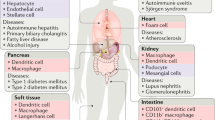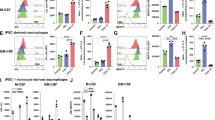Abstract
Macrophage recognition and ingestion of ‘self’ cells undergoing apoptosis in vivo protects tissues from the toxic contents of dying cells and modulates macrophage regulation of inflammatory and immune responses1,2. However, the complex molecular mechanisms mediating macrophage discrimination between viable and apoptotic cells are poorly understood2,3. In particular, little is known of why viable nucleated cells are not engulfed by macrophages. To reveal active repulsion of viable cells and to seek specific capture or ‘tethering’ of apoptotic cells, we studied macrophage binding of viable and apoptotic leukocytes under conditions of flow. We found that homophilic ligation of CD31 (ref. 4) on viable leukocytes promoted their active, temperature-dependent detachment under low shear, whereas such CD31-mediated detachment was disabled in apoptotic leukocytes, promoting tight binding and macrophage ingestion of dying cells. Here we propose that CD31 (also known as platelet-endothelial cell adhesion molecule-1, PECAM-1) is an example of a cell-surface molecule that prevents phagocyte ingestion of closely apposed viable cells by transmitting ‘detachment’ signals, and which changes function on apoptosis, promoting tethering of dying cells to phagocytes.
This is a preview of subscription content, access via your institution
Access options
Subscribe to this journal
Receive 51 print issues and online access
$199.00 per year
only $3.90 per issue
Buy this article
- Purchase on Springer Link
- Instant access to full article PDF
Prices may be subject to local taxes which are calculated during checkout





Similar content being viewed by others
References
Kerr, J. F., Wyllie, A. H. & Currie, A. R. Apoptosis: a basic biological phenomenon with wide-ranging implications in tissue kinetics. Br. J. Cancer 26, 239–257 (1972)
Savill, J. & Fadok, V. Corpse clearance defines the meaning of cell death. Nature 407, 784–788 (2000)
Green, D. R. & Beere, H. M. Apoptosis. Mostly dead. Nature 412, 133–135 (2001)
Newman, P. J. The biology of PECAM-1. J. Clin. Invest. 99, 3–8 (1997)
Sakariassen, K. S., Aarts, P. A., de Groot, P. G., Houdijk, W. P. & Sixma, J. J. A perfusion chamber developed to investigate platelet interaction in flowing blood with human vessel wall cells, their extracellular matrix, and purified components. J. Lab. Clin. Med. 102, 522–535 (1983)
Savill, J., Dransfield, I., Hogg, N. & Haslett, C. Vitronectin receptor-mediated phagocytosis of cells undergoing apoptosis. Nature 343, 170–173 (1990)
Rainger, G. E., Buckley, C., Simmons, D. L. & Nash, G. B. Cross-talk between cell adhesion molecules regulates the migration velocity of neutrophils. Curr. Biol. 7, 316–325 (1997)
Muller, W. A., Weigl, S. A., Deng, X. & Phillips, D. M. PECAM-1 is required for transendothelial migration of leukocytes. J. Exp. Med. 178, 449–460 (1993)
Reedquist, K. A. et al. The small GTPase, Rap1, mediates CD31-induced integrin adhesion. J. Cell Biol. 20, 1151–1158 (2000)
Newton, J. P., Buckley, C. D., Jones, E. Y. & Simmons, D. L. Residues on both faces of the first immunoglobulin fold contribute to homophilic binding sites of PECAM-1/CD31. J. Biol. Chem. 272, 20555–20563 (1997)
Pumphrey, N. J. et al. Differential association of cytoplasmic signalling molecules SHP-1, SHP-2, SHIP and phospholipase C-γ1 with PECAM-1/CD31. FEBS Lett. 450, 77–83 (1999)
Savill, J., Hogg, N., Ren, Y. & Haslett, C. Thrombospondin cooperates with CD36 and the vitronectin receptor in macrophage recognition of neutrophils undergoing apoptosis. J. Clin. Invest. 90, 1513–1522 (1992)
Ren, Y., Silverstein, R. L., Allen, J. & Savill, J. CD36 gene transfer confers capacity for phagocytosis of cells undergoing apoptosis. J. Exp Med. 181, 1857–1862 (1995)
Fadok, V. A. et al. A receptor for phosphatidylserine-specific clearance of apoptotic cells. Nature 405, 85–90 (2000)
Oldenborg, P. A. et al. Role of CD47 as a marker of self on red blood cells. Science 288, 2051–2054 (2000)
Mansfield, P. J., Boxer, L. A. & Suchard, S. J. Thrombospondin stimulates motility of human neutrophils. J. Cell Biol. 111, 3077–3086 (1990)
Savill, J. S. et al. C. Macrophage phagocytosis of aging neutrophils in inflammation. Programmed cell death in the neutrophil leads to its recognition by macrophages. J. Clin. Invest. 83, 865–875 (1989)
Brown, S. B., Bailey, K. & Savill, J. Actin is cleaved during constitutive apoptosis. Biochem. J. 323, 233–237 (1997)
Bird, I. N. et al. Homophilic PECAM-1 (CD31) interactions prevent endothelial cell apoptosis but do not support cell spreading or migration. J. Cell Sci. 112, 1989–1997 (1999)
Brown, S. B., Clarke, M. C., Magowan, L., Sanderson, H. & Savill, J. Constitutive death of platelets leading to scavenger receptor-mediated phagocytosis. A caspase-independent cell clearance program. J. Biol. Chem. 275, 5987–5996 (2000)
Metzelaar, M. J., Korteweg, J., Sixma, J. J. & Nieuwenhuis, H. K. Biochemical characterization of PECAM-1 (CD31 antigen) on human platelets. Thromb. Haemost. 66, 700–707 (1991)
Acknowledgements
We would particularly like to acknowledge C. Stewart, E. Drost and W. MacNee for assisting in establishing a flow-based approach; H. Jersmann for help with a number of FACS-based phagocytosis assays; A. Rossi for help with calcium flux studies; and C. Haslett and M. Salmon for discussion. Work was funded by the Wellcome Trust, the Chief Scientist Office of the Scottish Executive, and a Wellcome Trust International Fellowship to I.H.
Author information
Authors and Affiliations
Corresponding author
Ethics declarations
Competing interests
The authors declare that they have no competing financial interests
Rights and permissions
About this article
Cite this article
Brown, S., Heinisch, I., Ross, E. et al. Apoptosis disables CD31-mediated cell detachment from phagocytes promoting binding and engulfment. Nature 418, 200–203 (2002). https://doi.org/10.1038/nature00811
Received:
Accepted:
Issue Date:
DOI: https://doi.org/10.1038/nature00811
This article is cited by
-
Comparison of immunotherapy mediated by apoptotic bodies, microvesicles and exosomes: apoptotic bodies’ unique anti-inflammatory potential
Journal of Translational Medicine (2023)
-
Microglia at the Centre of Brain Research: Accomplishments and Challenges for the Future
Neurochemical Research (2022)
-
Regulation of efferocytosis as a novel cancer therapy
Cell Communication and Signaling (2020)
-
The role of phosphatidylserine recognition receptors in multiple biological functions
Cellular & Molecular Biology Letters (2020)
-
Age-related blunting of the phagocyte arsenal and its art of killing
Current Molecular Biology Reports (2020)
Comments
By submitting a comment you agree to abide by our Terms and Community Guidelines. If you find something abusive or that does not comply with our terms or guidelines please flag it as inappropriate.



